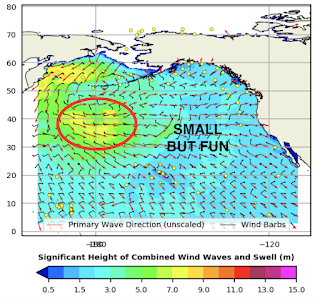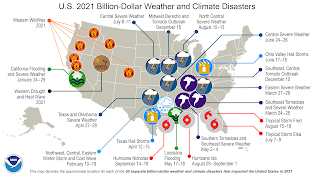NEWS OF THE WEEK:
I don't know about you, but that blast in Tonga last week absolutely FLOORED me. It just put into perspective how small we are on this planet. And the smallest hiccup by our planet, the sun, etc. can have devastating consequences. Amazingly, that blast had been building for a few weeks prior to the main eruption. So what exactly happened? I'll let National Geographic explain:
Just a few weeks ago, a submarine volcano identifiable by two small uninhabitable islands in the Kingdom of Tonga began to erupt. Its outburst initially seemed innocuous, with ashen plumes and moderate explosions that few people living outside the archipelago noticed.
But this past weekend, that volcano, named Hunga Tonga-Hunga Ha'apai, forced the world to sit up and pay attention. After a moment of calm earlier this month, its eruptive activity turned increasingly violent. The middle section of the island vanished on satellite imagery. Towering columns of ash began to produce record-breaking amounts of lightning.
“The thing just went gangbusters,” says Chris Vagasky, meteorologist and lightning applications manager at the Finland-based weather measurements company Vaisala. “We were starting to get 5,000 or 6,000 events per minute. That’s a hundred events per second. It’s unbelievable.”
Then, early in the morning on January 15, the volcano produced a colossal explosion. The atmosphere was blasted out of the way as a shockwave emanated from the island, radiating outward at close to the speed of sound. The sonic boom was heard in parts of New Zealand more than 1,300 miles away, with the shockwave eventually traveling halfway around the world—as far as the United Kingdom, which is located a staggering 10,000 miles distant.
To everyone’s horror, a tsunami quickly followed. It hit Tongatapu, the kingdom’s main island and home to the capital Nuku'alofa, just a few dozen miles to the south of the volcano. Communications were knocked out as the streets began to flood and people fled for their lives. Tsunami waves, albeit smaller ones, rushed across the vast ocean to parts of the Pacific Northwest, causing surges in Alaska, Oregon, Washington State, and British Columbia. Stations in California, Mexico, and parts of South America also registered minor tsunami waves.
Recent research on the geologic history of the volcano suggests that this powerful paroxysm is, on human timescales, a relatively rare event: Such an explosion is thought to occur roughly once every thousand years. The hope is that the worst of the eruption is over. But even if that turns out to be the case, the damage has already been done.
Scientists and a rattled public are eager to know what caused such a powerful eruption, and what may happen next. But information has been slow to emerge partly because the volcano is somewhat remote and difficult to observe up close. “There are far more questions than answers at this point,” Krippner says. But here’s what scientists do know about the tectonic and geologic drivers involved, and what they might mean for the volcano’s future.
A VOLCANIC POWERHOUSE IN THE PACIFIC
Hunga Tonga-Hunga Ha'apai is located in region of the South Pacific that’s jam-packed with volcanoes—some above the waves, some far below—that have a penchant for violent eruptions. Past events have unleashed city-size rafts of pumice or seen volcanoes blowing themselves apart only to build new islands immediately afterward.
This profusion of volcanoes exists because of the Pacific plate’s continuous dive beneath the Australian tectonic plate. As the slab descends into the superhot rocks of the mantle, the water inside gets baked out and rises into the mantle above. Adding water to these rocks causes them to more readily melt. This creates a lot of magma that tends to be sticky and filled with gas—a potent recipe for explosive eruptions.
Hunga Tonga-Hunga Ha'apai is no exception to this rule. The bits of land sit above a volcano more than 12 miles wide featuring a cauldron-like pit about three miles across, hidden from view by the sea. It’s been seen erupting with vim and vigor as far back as 1912, sometimes popping above the waves before being eroded away. The eruption of 2014-15 created a stable island that was soon home to colorful plants and barn owls.
When Hunga Tonga-Hunga Ha'apai started erupting again on December 19, 2021, it produced a series of blasts and an ash column 10 miles high, but it was doing “nothing out of the ordinary” for a submarine volcano, says Sam Mitchell, a volcanologist at the University of Bristol in the U.K. For the next few weeks, enough fresh lava erupted to expand the island by nearly 50 percent. And as the new year dawned, the volcano appeared to be calming down. Then, in the last couple of days, things took a turn for the dramatic.

THE VOLCANO’S MENACING MAELSTROM
As the volcano’s explosivity began to intensify, the amount of lightning emerging from its ashy plume began to eclipse not only that seen during this eruption, but during any eruption ever recorded.
Volcanoes can produce lightning because ash particles in their plumes bump into each other or into bits of ice in the atmosphere, which generates an electrical charge. Positive charges get segregated from negative ones, sparking a flash of lightning. (Learn more about how volcanoes can trigger lightning.)
During the first two weeks, lightening was recorded sometimes a few hundred or a few thousand flashes per day—nothing unusual. “It was clearing its throat, I guess,” says Vagasky. But by late Friday into early Saturday, the volcano was producing tens of thousands of discharges. At one point, this Tongan volcano managed 200,000 discharges in a single hour. By comparison, the 2018 eruption of Indonesia’s Anak Krakatau had 340,000 discharges over a week or so. “I couldn’t believe the numbers I was seeing,” says Vagasky. “You don’t usually see that with a volcano. This is something else. There was nowhere else that was that electric on the planet last night.”
It may have looked spectacular from afar, but up close it would have seemed apocalyptic, a constant blaze of light soundtracked by endless thunder and volcanic bellows. Most of the lightning wasn’t isolated to the plume but also hit the ground and the ocean. “This was extremely dangerous for anybody that’s sitting on any of the other Tongan islands, because you’ve got all this lightning coming down around you,” says Vagasky.
So why has this eruption produced what is likely to be a record-breaking number of discharges? The presence of water always ups the odds of lightning, says Kathleen McKee, a volcano acoustic researcher at the Los Alamos National Lab in New Mexico. When magma mingles with a shallow body of water, the trapped water is aggressively heated and vaporized, blasting that magma into millions of tiny pieces. The more plentiful and the finer the particles you have, the more lightning you generate.
The heat of the eruption also readily transports water vapor into the colder, higher reaches of the atmosphere, where it becomes ice, says Corrado Cimarelli, an experimental volcanologist at the Ludwig Maximilian University of Munich. That provides plenty of additional particles for the ash to collide with and generate electricity.

THE HEPHAESTION HAMMER FALLS
The astounding amount of lightning wasn’t the only prelude to the volcano’s cataclysmic blast. By Saturday morning, satellite imagery had revealed the island was no longer building itself: The middle of the volcanic isle had vanished, likely thanks to the uptick in explosivity.
When it eventually unleashed a giant explosion, the shockwave ricocheted across the globe at breakneck speeds. It was immediately followed by a tsunami that slammed into several islands in the Tongan archipelago before racing across the Pacific.
Jackie Caplan-Auerbach, a seismologist and volcanologist at Western Washington University in Bellingham, says the blast involved a “mind-boggling amount of energy.” But there isn’t enough data right now to ascertain the precise cause of the tsunami. These events require displacing a lot of water, which can happen through underwater explosions, through a collapse event—when lots of rock suddenly falls off the volcano into the sea—or a combination of these and other factors.
With the ash column obscuring the volcano, and much of the volcano submerged underwater, scientists will need time to gather more indirect data before drawing any conclusions. Clues could come from the types of acoustic waves the blast generated or perhaps the redistribution of mass around the volcano.
“The jury is still out,” Caplan-Auerbach says, but the fact that such an intense explosion and potent tsunami came out of this single, relatively small volcanic isle “speaks to the incredible power of this eruption.” And although not the cause of the main tsunami, the shockwave itself triggered another big wave: The rapidly moving air impacting the ocean was powerful enough to force water to move out of the way, a phenomenon called a meteotsunami.
Shane Cronin, a volcanologist at the University of Auckland in New Zealand, adds in a recent blog post that clues about why this event was so intense can be found in the volcano’s chemistry, which changes as the magmatic fuel within evolves over time.
This volcano, like many others, must refill its magma reservoir after a major eruption. The last of those in the region happened back in the year 1100; ever since, molten rock has been accumulating at depth. As it becomes mostly full, small amounts of magma leak out of the volcano, which is likely behind the eruptions recorded since 2009.
However, Cronin says, “once recharged, the large amount of magma crystallizing starts to drive gas pressures up, too quickly for it to be released by small eruptions.” Something’s got to give, and when that vast supply of magma finds an opening, it violently depressurizes and much of the molten reservoir is evacuated in one big blast.

A FOGGY FUTURE IN TONGA
The Tongan archipelago may owe its very existence to the infernal forces that constructed its islands in the first place, but it’s clear the cost of living on them can be steep. Only 100,000 people live in the kingdom, with about a quarter residing in the capital, and they are now besieged by ashfall and tsunami waves.
“The biggest unknown right now that really matters is we don’t know how the people in Tonga are,” Krippner says. This eruption, Mitchell adds, “could potentially be incredibly devastating to the country.”
So now comes the question everyone wants answered: “Is this eruption over?” Krippner says. “We don’t know.” Such a terrifying outburst may represent the effective decapitation the volcano’s shallow magma reservoir and the speedy exsanguination of its molten contents, Mitchell says. This eruption will be extensively studied by volcanologists, which will only improve their understanding of future events and bolster efforts to mitigate their effects. But it’s too soon to know for sure how things will unfold in the wake of this eruption. So for now, all eyes remain firmly fixed on Hunga Tonga-Hunga Ha'apai.
PIC OF THE WEEK:
Think I'm finally going to do it- I'm going off the grid. Bought this little slice of heaven up on the bluff with a farm to keep me busy. I'm going to surf that little left until my little arms can't paddle no more. Just going to keep my iPhone of course- gotta have my sports scores. And maybe my Sprinter Van in case there's some surf up the coast. And while I'm at it, I sure hope there's a Walmart nearby- can't live without my Ding Dongs! So maybe not entirely off the grid- just enough to never hear the word Tik Tok again.
Keep Surfing,
Michael W. Glenn
Undisputed
Already Using 6G On My iPhone 14
Only Verified Surfer To Get Barreled At San O' And Waikiki

























































